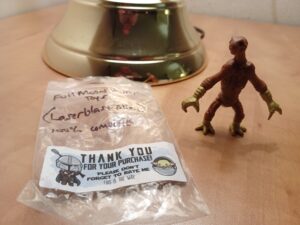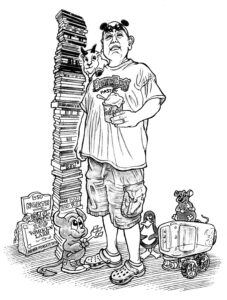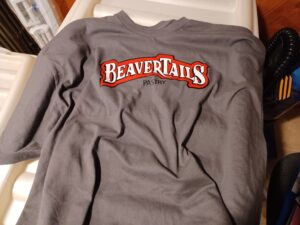This post went to Patronizers at the beginning of April, and to the public at the beginning of May. Yes, I know, everyone already patronizes me, but if you want me to pay attention sign up here.
As expected, the economy is in an unforced crash. Yippee! Buckle in folks, it’s gonna be a wild ride. I wish to thank all of y’all for backing me. Those folks who signed up to See the Sausage Being Made for $12 a year add up. The whole Patronizer thing often makes me feel like the founder of the world’s most useless cult, but you do keep the bank from taking the house and I am grateful.
I spent some time this month going through my bills. We’ve had the same cable company for almost twenty years and two different houses. (No TV, just a bit pipe.) Every few years, I’d get a letter that they were upgrading my plan. Fine. I gave them a call and told them to cut my bill or lose me. They cut the bill and upgraded my service again. I really need to put “negotiate with cable company” on my calendar for every two years.
Next up: the cell phone. We had Sprint because it worked here, which means we became T-Mobile, which means our bill had gone up. Probably switching to Consumer Cellular. It’s time to stretch those dollars!
Happier news: all active Tilted Windmill Press titles are in Bookvault, which means I will be able to sell them from my bookstore. Yay! I have a box of 21 proofs coming. If they are okay I’ll get them in the store.
I’m already offering the FreeBSD Storage Bundle in print at $24 off. I’m afraid to look at what I’ll have to charge for The Full Michael in print, but it’ll happen.
Okay, fine. Let me build a spreadsheet and add it up.
34 print books, $785. If I give a 20% discount that makes it $628. Call it $629.99. Nobody’s that insane, but if I don’t offer it one of you is gonna ask me why not. Plus, being able to offer it all feels correct. Like the bookstore is truly complete. You want it, I can send it!
Why do a 20% discount? When you buy direct from me, I don’t have to pay a bookstore or a distributor. 20% splits the difference with the reader, which seems fair. I do have paperwork and financial overhead on direct sales, though, so I’m compromising by offering the split on larger orders. Larger orders also save on shipping. Eventually I want to say “buy 4 or more get 20% off” but I implement only one headache at a time.
Sadly no, I can’t include No Starch titles. They are not print-on-demand. I would have to touch them and compute shipping. Not happening.
The question I’m still struggling with is the default format. I have to choose either “print/epub bundle” or “just epub.” Yes, people can change it with the “Format” drop-down. But defaults do impact people. Is it more ethical to set it to the less expensive option? How many people won’t see the “Format” option?
Clearly I need to pivot to “just give me all your money and I’ll decide what you get,” sigh.
I discovered a complication on direct print sales to Europe, though. The printer does not include commercial invoices. Bookvault does not know how much I charged you, or if I charged VAT. You can download an invoice with your order. I had one European customer who had trouble with this, but other Europeans say that’s fairly standard. I need to go through the print store and add that warning to every print version.
The good news is, I have the hard part of the networking book done. Sort of. I sent the TLS chapter to Bob Beck for review, and it went horribly wrong. The good news is, I get to do some new sysadmin stuff and set up QUIC on my web site. Then I get to do some netflow analysis and see how much of the traffic is QUIC versus everything else. Good fun times, for a strange value of good and stranger value of fun.
The good news is, the second half of the rest of N4SA2e requires very little in the way of updates. Some of the warnings need to be louder, but traceroute hasn’t changed, nor netcat.
Laserblasted is due back from copyedit on 15 May, and I’m wondering: if I can crank hard for two weeks, can I finish this draft and get it to tech review by then? I don’t know, but it’s a worthy goal. If nothing else, I’ll have two weeks of cramming on it.
Speaking of Laserblasted: as an experiment, it’ll be exclusive to my store for a few weeks before I release it on other bookstores. It’s a weird book so it’s not a real test of windowing, but I’ve heard from a few folks who missed the Kickstarter and maybe I’ll scoop them up that way.
Laserblasted also taught me a lesson. I had so much fun ranting about the film that I forgot to describe what the book is. Or: I spent so much time saying what it isn’t that I forgot to say what it is.
Meaning that I broke my own rule, and didn’t write the jacket copy before writing the book.
I still am struggling with the jacket copy. I might just steal my pal ZZ Claybourne’s description:
“What would happen if Gomer Pyle got turned into a scathing indictment of the military patriarchal industrial complex but with way more aliens and laser-inflicted explosions than the sitcom managed to achieve? Starring Brad Pitt as Gomer, directed by Sam Raimi.”
I’m scathing? When did this happen?
Er, uh–yeah. I meant to write that. What that says. I planned that. Yep.
Now to get back cover text that means that.
Maybe I’ll just put that on the back.
I really do need to get a Prohibition Orcs Christmas story written for my Christmas collection. Ideally I’ll launch the Twisted Presents Kickstarter on 25 July and be ready to fulfill immediately upon payment, so I can do the N4SA2e Kickstarter right after. Wait–does that work? Let’s sketch this out.
Let’s be pessimistic and say I finish end of May. I want a month for tech review, which means end of June.
I’ll have Laserblasted proofs ready and hard copies ordered before BSDCan, and order the books for delivery when I get home. Fulfill that by the end of June, no problem.
The copyeditor will have N4SA2e in July. She’s usually about six weeks on a tech book. I haven’t checked with her, of course, and she might blow up my entire schedule.
So if I launch Twisted Presents on 21 July and let it run for two weeks, it ends 4 August. I order books 5 August. Yes, I don’t have the money yet, but I’m assuming Kickstarter coughs up the dough on 18 August, like they do. I can ship them that week. It’s only a handful of copies, it’ll only take a day.
So I get the N4SA2e copyedits about 15 August and spend about a week doing corrections and laying out the print and indexing, all that crap. Launch that Kickstarter early September, let it run for three weeks. (Tech book campaigns should run longer than fiction ones.)
Now to work backwards.
Launching Twisted Presents on 21 July means I must have a print proof in hand by that date. I’ll need everything finalized by 7 July. I need the final manuscript end of June. Most of this book was previously published, but the orc tale needs copyediting and everything needs a final proofreading. I might have to use an alternate editor for that, someone less expensive at speed. That’ll take a couple weeks at best, which brings us up to the end of BSDCan. I’m not working on books during BSDCan. The book must go to copyedit by 9 June.
I need a few first readers to read the orc story. That takes two weeks.
I must have a completed orc story by 26 May. Achievable.
Except I’m cramming to finish N4SA2e by then.
Have I ever mentioned that I’m terrible at scheduling?
All of this is built on the very slender reed of finishing N4SA2e by the end of May. Which means I get QUIC on my web server.
I think I better go get to work.





